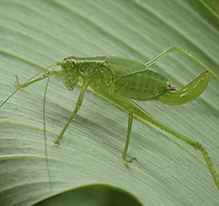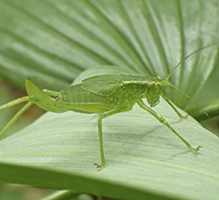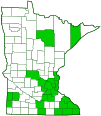northern bush katydid
(Scudderia septentrionalis)
Conservation • Description • Habitat • Ecology • Distribution • Taxonomy
|
|
||||||||||||||
Description |
Northern bush katydid is a common, small, bush katydid. It occurs in the United States from Maine to Virginia, west to Minnesota and eastern Kansas, and south along the Appalachian Mountains to northern Georgia. It occurs in southern Canada from Prince Edward Island west to eastern Ontario. It is common in Minnesota. Adults are active usually just in July and August, but sometimes as late as October. They are found in the canopy of deciduous trees. They have been recorded on tall shrubs, but these occurrences are believed to be incidental. They readily come to lights, and they are frequently seen on window screens. In older literature they are often referred to as rare. This was undoubtedly due to the species’ small size, its being active at night, and its occurrence high in the canopy of trees, which makes it difficult to capture. Leaf katydids (subfamily Phaneropterinae) are among the largest katydids in Minnesota, up to 2 9⁄16″ (64 mm) in total length. Bush katydids (genus Scudderia) are medium sized, 1 7⁄16″ to 2″ (36 to 50 mm) in total length. Northern bush katydids are very small for both the subfamily and the genus. The size for this species is given only in terms of body parts. The length of the thoracic plate (pronotum) and wings (tegmina), taken together, is 1 3⁄16″ to 1 5⁄16″ (30 to 32 mm). The body is slender, pale green, and more or less tinged with yellow. The head is short. The top of the head (vertex) is somewhat rounded. The face is nearly vertical. The eyes are small and rounded. The antennae are hair-like and long, much longer than the body but not reaching beyond the end of the tegmina. They are brownish on the outer half. They are attached high on the face and close together. The space between the antenna bases is less than the width of the first antennal segment. The pronotum is saddle shaped, green, and short. The upper side is flat, the rear margin is broadly rounded, and the sides are almost parallel, only slightly widened toward the rear. There is a longitudinal ridge (carina) in the middle, but it is faint and only on the rear half. The lateral lobes of the pronotum are bent downward at right angles to the top. They are flat and they are broadly rounded on the bottom. The angles where the sides turn downward are yellowish. The tegmina are long and narrow, more than four times but less than six times longer than wide. They are longer than the body on both sexes. The margins are almost parallel, but they are slightly widened toward the tip. They are entirely green. There are no black markings, and the part of the left tegmen that overlaps the right one is green. The hindwings are longer than the tegmina. On the male, there is a rearward, upper extension of the last abdominal segment, a dorsal process called the supra-anal plate. Unlike all other North American Scudderia, the supra-anal plate is nearly triangular, without a long, curved extension in the middle. Below the genitalia, another plate-like structure, the subgenital plate, is conspicuous, long, Y-shaped, and arched upward. It is not compressed toward the end. On the female, the ovipositor is more than 1.5 times longer than the pronotum. That is relatively short for a katydid, but relatively large for a bush katydid. It is broad, sword-shaped, and smoothly curved upward, not abruptly bent, on both the upper and lower margins. The legs are green. The front legs are short, the middle legs are a little longer, and the hind legs are much longer. The end section of each leg (tarsus), corresponding to the foot, has four segments. |
Size |
Small |
Song |
The song is very high pitched, from about 12 to 15 kHz. It is a series of soft ticks, followed by a sequence of usually 6 to 8 buzzes, described as dee-dee-dee-dee-dee-dee, ending with a series of loud ticks. The sequence of buzzes lasts about 3 seconds, with each buzz getting louder than the previous one. Listen to northern bush katydid |
|
Similar Species |
Habitat |
Deciduous woodlands |
Ecology |
Season |
One generation per year: |
Behavior |
|
Life Cycle |
|
Nymph Food |
|
Adult Food |
|
Distribution |
||
|
Sources GrylTett Database, content by Tom Walker (2016) Hebard, Morgan. (1932). The Orthoptera of Minnesota. University of Minnesota. Minnesota Agricultural Experiment Station. Retrieved from the University of Minnesota Digital Conservancy, https://hdl.handle.net/11299/204015. |
|
| 2/21/2024 | ||
Occurrence |
||
Common |
||
Taxonomy |
|
Order |
Orthoptera (Grasshoppers, Crickets, and Katydids) |
Suborder |
Ensifera (katydids, crickets, and allies) |
Infraorder |
Tettigoniidea (katydids, wētā, and allies) |
Superfamily |
Tettigonioidea |
Family |
Tettigoniidae (katydids) |
Subfamily |
Phaneropterinae (leaf katydids) |
Tribe |
Scudderiini |
Genus |
|
Subordinate Taxa |
|
|
|
Synonyms |
|
Phaneroptera septentrionalis Phaneroptera suturalis Scudderia angustifolia Scudderia truncata |
|
Common Names |
|
northern bush katydid northern bush-katydid |
|
Glossary
Ovipositor
A tube-like organ near the end of the abdomen of many female insects, used to prepare a place for an egg and to place the egg.
Pronotum
The exoskeletal plate on the upper side of the first segment of the thorax of an insect.
Subgenital plate
In male Orthoptera, the plate-like structure extending from the lower (ventral) side of the end of the abdomen underlying the genitalia.
Tarsus
On insects, the last two to five subdivisions of the leg, attached to the tibia; the foot. On spiders, the last segment of the leg. Plural: tarsi.
Tegmen
The modified, leathery front wing of grasshoppers and related insects that protects the hindwing. It may also serve as a camouflage, a defensive display, or a sound board. Plural: tegmina.
Vertex
The upper surface of an insect’s head.
Visitor Photos |
||
Share your photo of this insect. |
||
This button not working for you? |
||
Babette Kis |
||
 |
 |
|
Scudderia septentrionalis (northern bush katydid) Scudderia septentrionalis, northern bush katydid, on Solomon's seal leaf, at the Barnes Prairie hedgerow, Racine Co., WI. The green color of these katydids closely matches the leaves they're often found on, and it takes a sharp eye to spot them. This one was easier to see, as it was resting on the flipped over underside of the leaf. Photographed July 4, 2022. |
||
MinnesotaSeasons.com Photos |
||
|
||
|
||

Slideshows |
|

Visitor Videos |
||
Share your video of this insect. |
||
This button not working for you? |
||
|
Other Videos |
||
Scudderia septentrionalis, male singing on my hand. |
About
Dec 6, 2016 July 22nd 2016. |
Scudderia septentrionalis chante/singing - 2 |
About
Aug 21, 2016 Sauterelle septentrionale qui se déplace et chante. Northern Bush Katydid moving around and singing. |
Northern bush katydid |
About
Nov 16, 2016 Scudderia Septentrionalis. |

Visitor Sightings |
||
Report a sighting of this insect. |
||
This button not working for you? |
||
MinnesotaSeasons.com Sightings |
||
|

|
Created: 2/21/2024 Last Updated: © MinnesotaSeasons.com. All rights reserved. |

